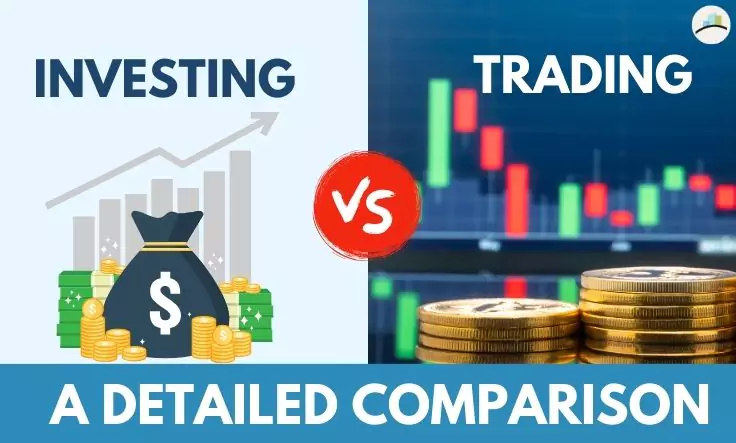In the vast realm of finance, two predominant methodologies stand out: investing and trading. Both avenues offer pathways to financial prosperity, yet they diverge significantly in their approaches, time horizons, and risk management strategies. In this comprehensive analysis, we will embark on a detailed exploration of the nuanced differences between investing and trading, delving into their respective intricacies, advantages, and considerations.
Investing:
Investing is about sticking to a plan to grow wealth over a long time. Investors take their time and carefully decide how to invest, aiming to make their money grow more and more over many years. They do this by putting together a mix of different investments like stocks, bonds, mutual funds, and ETFs. Their goal is to see their money grow by increasing in value and paying out regular income over time.
Types of Investing:
- Value Investing - This approach aims at reducing the risk to maintain the value of the investment. Investors purchase shares of only well-established companies. There is less growth in this approach.
- Growth Investing - This approach focuses on growing the value of investments. Investors purchase stocks that have higher growth potential. This increases the risk quotient as well as the growth prospects.
Key Features:
- Time Horizon: Investors typically have a long-term perspective, thinking about their investments over many years or even decades. They're not too worried about short-term ups and downs in the market. Instead, they focus on how well their investments are doing overall and how much they could grow over time.
- Risk Tolerance: Investors, who are in it for the long haul, usually are more comfortable with taking on risk and are okay with dealing with the ups and downs of the market in the short term as they aim for their financial goals.
- Investment Styles: There are two main ways investors can go about investing - active or passive. Active investors like to keep a close eye on their investments, adjusting them regularly to try and beat the market by choosing the right mix of assets. On the other hand, passive investors prefer to stick with a "buy and hold" strategy, aiming to match the returns of a standard market index without making too many changes.
Advantages:
- Compound Growth: Investing facilitates the harnessing of compounding returns, wherein earnings generate additional gains over time, leading to exponential wealth accumulation.
- Diversification: By spreading investments across various asset classes and sectors, investors mitigate risk and guard against the adverse impact of market downturns.
- Tax Efficiency: Long-term investments often benefit from favourable tax treatment, with lower capital gains tax rates applicable to assets held for extended periods.
Examples: Common avenues for long-term investing include retirement accounts such as 401(k)s and IRAs, where individuals allocate funds to secure their financial futures during retirement.
Trading:
While investing takes a patient approach, trading is all about acting fast to make the most of opportunities in the financial markets. Traders thrive on short-term price movements and market fluctuations, swiftly making transactions to turn a profit within short timeframes. They stay on their toes, constantly monitoring the markets and making quick decisions to capitalize on emerging trends and market shifts.
Types of Trading:
- Position Trading: These traders buy and hold stock for a few months. They look for the best-selling opportunities within this span to gain from.
- Swing Trading: These traders purchase a stock for days or weeks to gain from the anticipated upward movement.
- Day Trading: Day traders buy stocks in the morning and sell them before the market closes. The idea is to capitalize on a single-day rally caused by positive news or market sentiment.
- Scalp Traders: Scalp traders keep high margins in play to gain from the smallest possible price changes. These traders buy a stock for a few seconds or a few minutes. They make a profit out of the tiniest opportunity.
Key Features:
- Time Horizon: Traders work with a much shorter time frame, usually from minutes to days. They focus on taking advantage of quick changes in the market and price movements to make profits fast. Their strategies are all about finding and capitalizing on short-term opportunities in the market.
- Risk Management: Because short-term trading can be unpredictable, traders use strong risk management methods to stay safe. They might use things like stop-loss orders, which automatically sell off a position if it starts losing too much value, and position sizing, which means only investing a small portion of their capital in any one trade. These techniques help them control losses and protect their investment money.
- Trading Styles: Traders employ different trading strategies based on their preferred holding period and risk tolerance. These strategies include Position Trading, Swing Trading, Day Trading, and Scalping, each catering to distinct preferences and objectives.
Advantages:
- Potential for High Returns: Trading offers the allure of rapid wealth accumulation, with the potential for significant returns within compressed time frames.
- Flexibility: Traders possess the agility to adapt to evolving market conditions and capitalize on emerging opportunities, thereby optimizing their trading strategies for maximum efficiency.
- Liquidity: With access to highly liquid markets, traders can swiftly enter and exit positions, capitalising on price movements and market dynamics with ease.
Examples: Day traders, swing traders, and scalpers represent common archetypes within the realm of active trading, each employing distinct strategies tailored to their preferred holding periods and risk appetites.
Key Differences:
- Time Horizon:
Investing: Typically involves a long-term approach, where assets are held for years or even decades with the goal of wealth accumulation over time.
Trading: Focuses on short-term gains, with assets being bought and sold within days, hours, or even minutes, based on market fluctuations.
- Risk Exposure:
Investing: Generally carries lower risk compared to trading due to the longer time horizon, allowing for potential market fluctuations to average out over time.
Trading: Involves higher risk due to the frequent buying and selling of assets within short time frames, exposing traders to rapid market movements and volatility.
- Effort and Expertise:
Investing: Requires less time and expertise compared to trading since it involves a buy-and-hold strategy where investors rely on fundamental analysis and long-term market trends.
Trading: Demands a significant amount of time, effort, and expertise as traders need to constantly monitor market conditions, analyze charts, employ technical indicators, and stay updated with news events to make quick and informed decisions.
- Tax Implications:
Investing: Long-term capital gains tax rates typically apply to profits made from investments held for over a year, which are often lower than short-term capital gains tax rates.
Trading: Profits from short-term trades are subject to higher short-term capital gains tax rates, which can significantly impact overall returns. Traders need to consider tax implications when devising trading strategies to optimize their after-tax profits.
- Psychological Factors:
Investing: Emphasizes patience and discipline, as investors need to withstand market fluctuations and resist the urge to make impulsive decisions based on short-term volatility.
Trading: Requires strong emotional control and discipline to manage the psychological pressures of quick decision-making, handling losses, and avoiding overtrading.
- Market Knowledge and Analysis:
Investing: Relies more on fundamental analysis, focusing on the financial health and long-term prospects of companies or assets.
Trading: Requires proficiency in technical analysis and, an understanding of chart patterns, trends, and market indicators to identify short-term trading opportunities and execute timely trades.
- Transaction Costs and Fees:
Investing: Typically incurs lower transaction costs since investments are held for longer periods, resulting in fewer transactions.
Trading: Involves higher transaction costs due to the frequent buying and selling of assets, including commissions, spreads, and other trading fees, which can eat into profits if not managed effectively.
FAQs:
Which is better Trading or Investing?
Investing is where you buy stocks for longer periods to earn an additional income or profit over time. It requires patiently holding the shares you have invested in, for years or even decades.
Which is better, trading or investing?
Trading and investing are two different styles of participating in the stock market and each has its advantages and disadvantages. The major point of difference between them lies in the period involved and the risk.
Which method earns more profit, investors, or traders?
Traditionally both traders and investors have done well for themselves and the returns through both methods cannot be compared as the process involved is very different. If you are good with your analytical skills, you can earn profit in both trading and investing, however, earning profits in trading would require you to refine your skills even further. If performed with the right approach both can be profitable.
Can profits be promised on long-term investments?
Profits cannot be promised in both trading and investing. Making profits would depend on how your chosen stock performs in the long run. It requires patience and a careful approach to build a profitable portfolio.
Demat account and Trading account difference?
A Demat account holds the securities (bonds, shares, mutual funds, etc.) digitally, while a trading account is used to place orders in the share market.
Swing Trading vs. Day Trading: What's the Difference?
Swing trading involves holding onto stocks for a few days to weeks, aiming to profit from short-term price fluctuations. Day trading, on the other hand, involves buying and selling stocks within the same trading day. The main difference lies in the holding period: swing trading is more medium-term, while day trading is ultra-short-term.
In Conclusion:
In the world of money, there are two main ways to grow wealth: investing and trading. Investing is like planting seeds for long-term growth, while trading is like seizing quick opportunities in the market. To do either well, it's crucial to know the differences and match them with your goals, how much risk you can handle, and how long you plan to invest. By really understanding both methods, and being careful and disciplined in how you use them, you can confidently deal with the ups and downs of finance, and hopefully, come out successful.











 1,499
1,499
